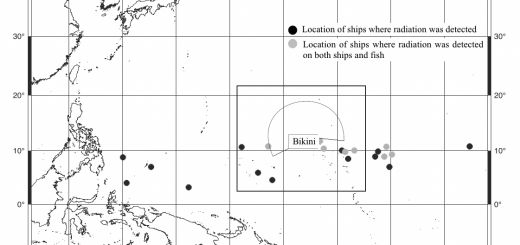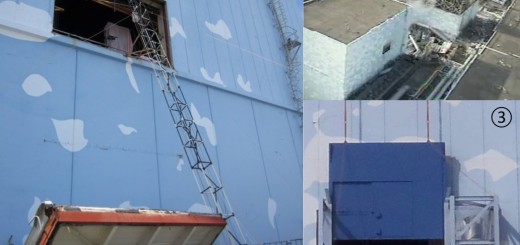CNIC recently released two statements on court cases related to nuclear issues, which we have translated into English so that international readers can see our position on these important court rulings as well as get an update on what is happening on the legal scene in Japan. One year ago, NIT (No. 172) published an article on court cases associated with nuclear facilities in Japan after the Otsu District Court in Shiga Prefecture, western Japan, had issued a provisional injunction ordering Kansai Electric Power Company (KEPCO) to shut down Takahama Units 3 and 4. Unfortunately this court order was overturned by the Osaka High Court, the subject of one of the CNIC statements below. The other statement applauds the Maebashi District Court for its ruling which makes clear that the government of Japan and the Tokyo Electric Power Company (TEPCO) may be liable for the Fukushima Daiichi accident.
Although the higher court in Osaka overturned the lower court’s injunction on Takahama, the fact that this NPP was unable to operate over the last year is significant, both in terms of reducing the risk of an accident during this time and in disrupting the finances and planning of KEPCO. It is hoped that the Maebashi District Court’s judgment will not be overturned even though TEPCO and the government have lodged an appeal.
CNIC Statement: We question the attitude of the Osaka High Court and Hiroshima District Court, both of which agreed on the restart of nuclear power stations, in lockstep with the government
April 7, 2017 NPO Citizens’ Nuclear Information Center
The ruling issued by the Osaka High Court on March 28, 2017 was in favor of Kansai Electric Power Company (KEPCO), rejecting the local residents’ request to keep Takahama Units 3 and 4 shut down. Following this ruling, on March 30, the Hiroshima District Court turned down the request of local residents to shut down Shikoku Electric Power Company’s Ikata Unit 3.
These court decisions disrespect the seriousness of the accident of Tokyo Electric Power Company’s Fukushima Daiichi Nuclear Power Station, which, six years after its occurrence, shows no sign of ending and has caused horrific problems for many local residents. Back on March 9, 2016, the Otsu District Court issued a provisional injunction ordering KEPCO, the operator, to shut down Takahama Units 3 and 4, which were in commercial operation at that time. KEPCO filed an objection, which was turned down by the same district court on July 12, 2016. The Osaka High Court overturned these two decisions.
The court ruling concerning Ikata Unit 3 was issued as a response to the request submitted by residents living within 100 kilometers of the power plant, in Hiroshima City and Matsuyama City, who were seeking a provisional injunction to shut down the reactor to protect their personal rights.
1) According to the two court rulings, it should be rational that the new regulatory requirements for nuclear power reactors established by the Nuclear Regulation Authority are the basis on which to determine the safety of reactors. However, specialists and researchers have criticized the requirements in many respects, revealing that they leave a wide margin for discussion. By no means they are “safety standards,” as the chairperson of the Authority himself has clearly admitted. Another reason is that the investigation to completely clarify the causes of the Fukushima Daiichi accident has not been completed. “The specific damage to the facilities and the causes of the damage remain partially unknown,” stated the Osaka ruling concerning the accident. This is an astonishing understatement. It is precisely because of this that the Niigata Prefecture Technical Committee on the Safety and Control of Nuclear Facilities is continuing its investigation into the causes of the accident.
2) If a severe nuclear accident occurs, will every resident be able to evacuate without exposure to radioactivity?
Regarding this issue, the Osaka ruling stated that it is not unreasonable that the new regulatory requirements include only the first to fourth layers of the multi-layer protection in the scope of the regulations and do not include the fifth layer, nuclear emergency preparedness. This judgment is simply wrong.
The court ruing says that the nuclear emergency preparedness measures, including evacuation plans, should be properly implemented mainly by the nuclear power operator, national government and municipal governments, through their cooperation. Now what do we mean by proper in reality? Is it possible for any party to evaluate whether an evacuation plan is proper and feasible? It is impossible to release proper information on the discharge of radioactive materials and the risk of exposure to radioactivity continually and in a timely manner as the accident unfolds, while providing instructions for an evacuation that is free from exposure to radioactivity. It is exactly the Nuclear Regulation Authority itself that should be responsible for nuclear emergency preparedness.
Thus the possibility of another severe nuclear accident is undeniable and residents are forced to live with the anxiety of the occurrence of another accident of the same scale as, or greater than, the Fukushima Daiichi accident.
CNIC Statement: We welcome the Maebashi District Court’s ruling
March 23, 2017 NPO Citizens’ Nuclear Information Center
On March 17, 2017, the Maebashi District Court delivered a decision in the group lawsuit, which had been filed by evacuees of the Fukushima Daiichi accident and those affected, clearly stating that both the government of Japan and Tokyo Electric Power Company (TEPCO) are liable for the accident. The court ordered that the two defendants should jointly pay the plaintiffs a compensation fifty-fifty for their emotional distress caused by the infringement of their “right to live a peaceful life” (details below).
Regarding the causes of the accident, the ruling stated that seismic motion could not be acknowledged as a factor. Our position concerning the causes of the accident is that the investigation has not advanced sufficiently to make such a clear-cut judgment. Nevertheless, it is certain that TEPCO’s breach of obligation and the government’s illegal negligence contributed to the severe accident — the operator failed to take sufficient measures against tsunami risks while the government failed to order the operator to take action. We would like to applaud the Maebashi ruling in that it condemned both defendents for their inaction, even though it is a corollary of the facts that have become apparent thus far through various investigations.
The ruling acknowledged that damage by tsunami was foreseeable and that TEPCO deserves reproach because “clearly the operator prioritized economical rationality over safety measures against tsunami.” In addition, the ruling says: “TEPCO did not even implement provisional countermeasures that could have been completed in about one year — which were power-vehicle placement and cable installation — although they would have been easy in terms of both time and cost.”
The ruling was clear and persuasive.
The court also turned down the allegation of the government, which insisted that it did not have regulatory power, as irrational. “If the government had exercised its regulative power, the accident could have been prevented.” The ruling blocked the government from evading responsibility, presenting specific examples of exercise of power. It is certain that upcoming rulings on the Fukushima Daiichi accident will incorporate this indication by the Maebashi court.
Needless to say, the ruling is not meant to draw a generalized conclusion, namely, “nuclear power generation is safe if the government correctly exercises authority and the operator takes proper measures.”
To our regret, however, while it clearly acknowledges the responsibility of TEPCO and the government, the ruling is not sufficiently empathetic towards the painful feelings of those evacuees who have lost their homes.
There were 137 plaintiffs when the lawsuit was filed. Three have passed away since then. Four were not yet born at the time of the accident. Of the remaining 130, only 62 were found eligible for monetary compensation for pain and suffering: Of the 72 plaintiffs whose homes were in the evacuation zone, 19 were judged eligible to receive the “payment of claim approval” (750 thousand to 3.5 million yen each), and of the 58 plaintiffs who left their homes “on their own decision,” 43 were judged eligible (70 thousand to 730 thousand yen each, excluding one plaintiff who was found eligible for 1.02 million yen including compensation for a deceased plaintiff). The plaintiffs originally claimed 11 million yen each (of which 1 million was to be allotted to attorneys’ fees); the awarded compensation was far lower than what the plaintiffs had sought.
The ruling acknowledged that the “interim guidelines” established by the Dispute Reconciliation Committee for Compensation of Nuclear Damage are reasonable, because the guidelines would enable prompt and consistent damage compensation. However, isn’t it whether the designation of evacuation zones by the government was reasonable that should have been questioned? We hope to hear more persuasive court rulings in this regard in the future.
The judiciary should be independent of the preferences of nuclear operators or government and place maximum priority on protecting the personal rights of people.


